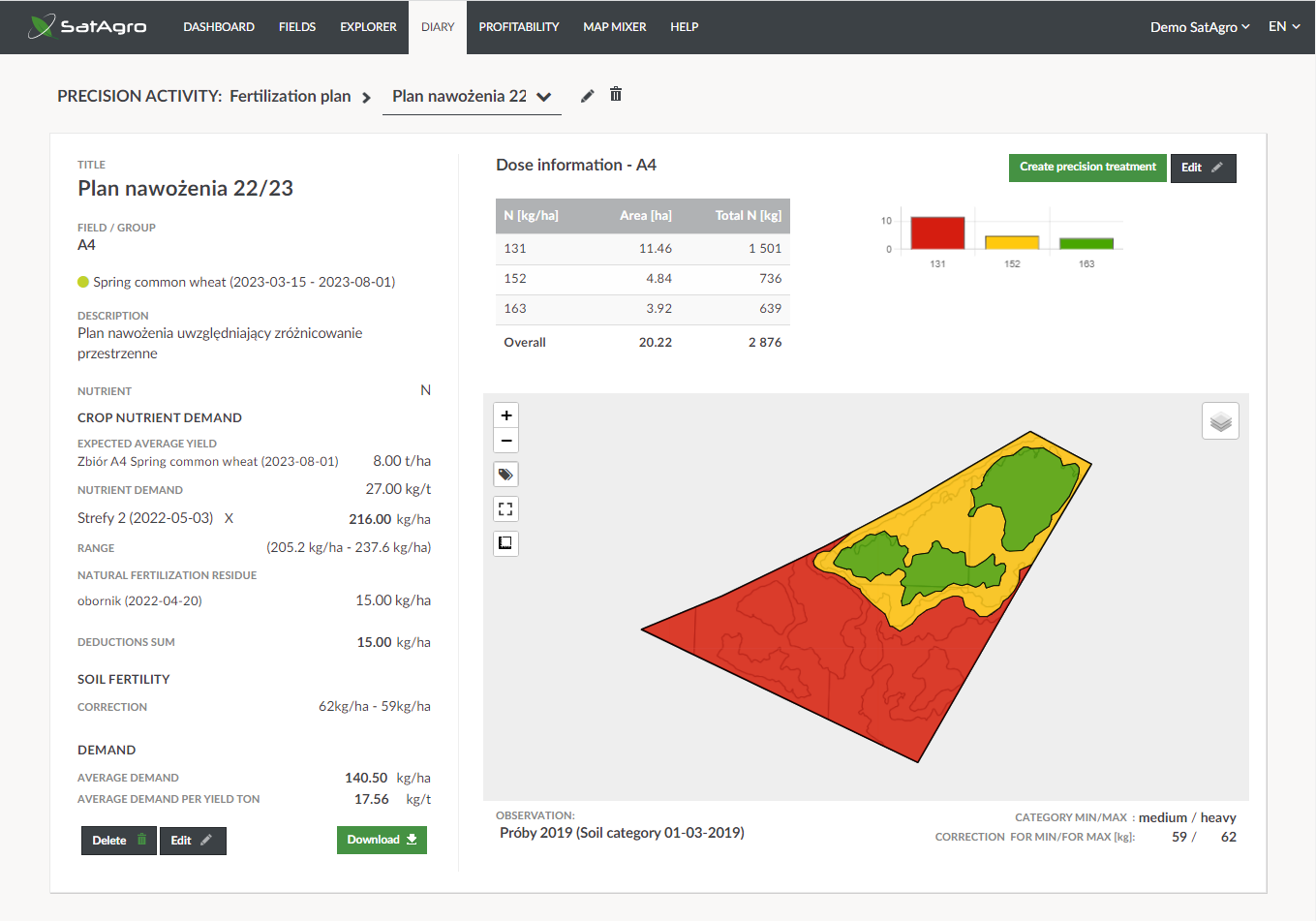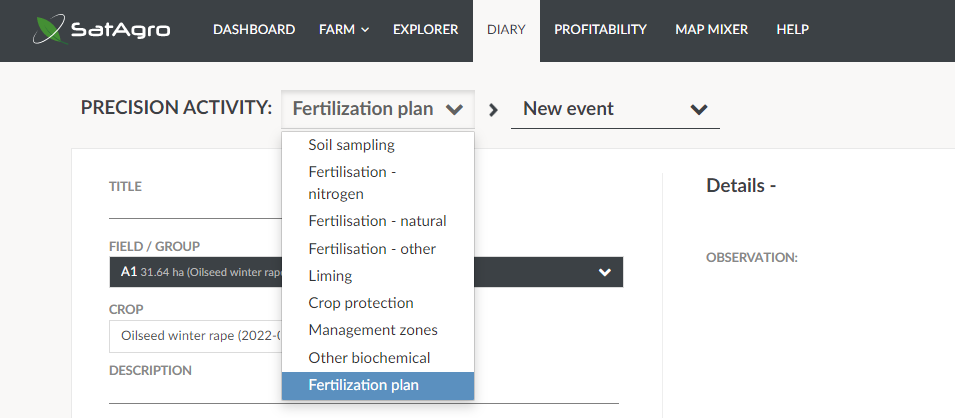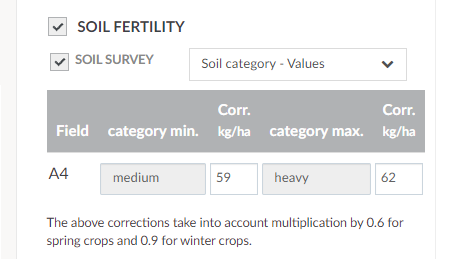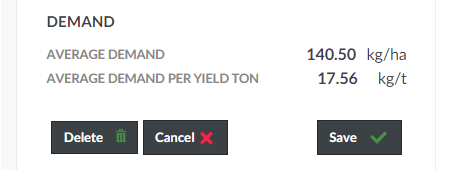03/29/2023
The Fertilisation Plan defines the optimum quantities of basic nutrients to be supplied to the crop in order to provide it with the right conditions for growth. A reliable plan requires both the determination of the crop nutrient needs and an estimate of the amount of nutrients currently available in the soil. The SatAgro platform offers a simple tool for developing Fertilisation Plans and supports farms in their implementation.
The implemented Fertilisation Plans are compatible with the requirements of the eco-scheme “Carbon Farming and Nutrient Management”, and at the same time allow to take into account the spatial variability of the canopy and its habitat, in accordance with the principles of precision agriculture. This further improves the profitability of production and reduces the negative environmental effects of fertiliser use.
The Fertilisation Plan module implements a number of applicable legal acts and standards, including the Regulation of the Council of Ministers of 31 January 2023 on the ‘Programme of measures to reduce water pollution by nitrates from agricultural sources and to prevent further pollution’ (which transposes the Nitrates Directive 91/676/EEC) and a set of publications by the Agricultural Advisory Centre in Brwinów, Poland.
According to the guidelines of the Agency for the Restructuring and Modernisation of Agriculture, eco-scheme-compliant fertilisation plans, specifying the doses of nutrients (N, P, K, Mg and the need for liming), can be developed using the INTER-NAW tool, or any other tool developed specifically for that purpose.

Initial requirements
A number of parameters of the Fertilisation Plan can be automatically filled in by the SatAgro platform, in line with the eco-scheme requirements. For this to happen, the following information must be entered in the platform before the Plan is created:
- crop and yield history (two years back, or one year, depending on whether or not natural fertilisation is used on the farm), including intercropping;
- current crop structure, including expected yield;
- natural fertilisation treatments of the pre-crop – two years back;
- soil test results (phosphorus, potassium, magnesium, pH and optionally soil mineral nitrogen and calcium levels).
In addition, optionally, field management zones (also known as variable yield zones) can be defined, in order to account for the likely variation in crop yield.
Creating a new Fertilisation Plan
- Go to the Diary tab, available in the top menu of the platform;
- Create a new Precision Action by clicking on the “+” button. The Precision Action wizard will be launched;

- In the header of the wizard, select “Fertilisation Plan” from the drop-down list.

Completion of the Fertilisation Plan
General parameters

- Give the Plan a title, which will make it easier to find it later in the Diary tab;
- Select a crop field from the drop-down list;
- If a crop type is not displayed below the crop field name, then select the appropriate season and crop from the drop-down list that was created based on the crop rotation entered earlier;
- Enter a description of the plan, i.e. any comments concerning it, e.g. justification for the parameters entered, particularly if their values differ from the default ones.
- Select a macronutrient from the drop-down list
Crop nutrient requirement
- The ‘Expected yield’ is completed automatically based on the data entered together with the crop history. This element has a major impact on the entire Fertilisation Plan, as nutrient requirements depend primarily on the productivity of the crop.
- „Nutrient requirement” is expressed in kilograms of pure nutrient per tonne of yield, and specifies the amount the crop requires in order to produce 1 tonne of grain or biomass, depending on the type of crop defined previously. The value of the parameter is printed automatically.
- The “Management zones” parameter is optional. It allows considering the spatial variation in expected crop yield, based on predefined management zones (also known as variable yield zones). The previously defined management zones can be accessed via a drop-down list. When this option is applied, in addition to the average value of the crop nutrient demand, a range is also visible, which represents the variability resulting from the selected zones. As mentioned above, the magnitude of expected yield is the main factor shaping fertiliser needs, so the use of management zones will most often result in significant variability in the amount of fertiliser required in different parts of the field. It will also bring the Plan closer to the crop’s actual requirements. In practice, this option works in such a way that the yield level in each field zone is calculated by multiplying the relative yield (% of average), coded in the management zone, by the expected average yield (9).
Deductions

- When the “Deductions” box is ticked, it will unlock the possibility to take into account several factors that reduce the pre-estimated nutrient requirement.
- In the case of the Nitrogen Fertilisation Plan, the first element of “Deductions” is called “N from legumes / leaves of root crops” (referring to nitrogen left from a Fabaceae crop in pure sowing, crop mixtures or root crops with a high nitrogen content in the leaves), and in other cases it is “Crop residue corr.”. These differences are related to the requirements of the Nitrates Directive and, at the same time, are due to the high mobility of nitrogen, the availability of which in mineralised form is additionally taken into account in point 16, described below. On the other hand, in the P, K, Mg Plan variant it is possible to deduct the nutrients from the pre-crop residues. Here, the nutrient amount is calculated automatically on the basis of the pre-crop yield, the ratio of seed to crop residue, the composition of the crop residue and the utilisation factor of its components.
- “Natural fertilisation residues” refers to fertilisation treatments carried out before the pre-crop. Fertilisation carried out after the harvest of the pre-crop is considered as fertilisation of the successor crop (to which this Plan refers), which realises the Plan, and therefore it is not considered in the “Deductions” section.
- The “Deductions sum” (15) is calculated automatically and notifies the total amount of an nutrient deductible from the crop’s initially estimated requirement.
Soil nutrient status

- Ticking the box “Soil nutrient status” (16) unlocks the possibility of taking into account this important factor shaping fertiliser needs. A table is activated which refers to soil nutrient status and soil category.
In the simplest, non-precise (or non-spatially-explicit) variant, it is possible to manually enter the soil category on the basis of which, and the crop type, the amount of mineral nitrogen will be computed. This option is useful when mineral nitrogen has not been established in soil survey and the soil is uniform across the crop field.
However, the target functionality of the Plan, compulsory for P, K, Mg and Ca, is achieved when soil sampling results are taken into account. The previously integrated results, in a form of a set of maps, are available from the ‘Soil survey’ drop-down list.
When defining the nitrogen fertilisation plan, in case the optional mineral nitrogen measurement has not been carried out but the soil has been surveyed, select the same soil sampling results as for the other nutrients, and the estimated mineral nitrogen estimate will be done on the basis of the assumed average component content per soil category. The values thus estimated are then subtracted from the pre-estimated crop nutrient requirement.
Due to the high mobility of mineral nitrogen, the results are also influenced by efficiency factors. For winter crops, the N use efficiency is – 90% and for spring crops – 60%.
In the case of the plan for P, K, Mg, appropriate fertilisation adjustments are computed in order to bring soil nutrient status to the optimum level. For these nutrients, the results calculated up to this point are multiplied by the appropriate factor, ranging from 150% for very low soil abundance (in order to improve soil nutrient status) to 50% for very high abundance (in order to take advantage of the soil nutrient status).
Demand after deductions

- “Demand after deductions” shows the final estimate of the demand for nutrient from fertilisers. The values given are expressed in kilograms per hectare, and in kilograms per tonne of yield. They can be compared with the corresponding initial estimates from the section “crop nutrient demand”, not takind into account any deductions.
Saving of the Plan and its realisation
- Once you have completed the above sections, click on the “Save” button. After a short while, on the right-hand side of the screen, a crop nutrient requirement map will be displayed. In the table above the map, and on the histogram, you will find additional information on the generated zones, their area in hectares and their percentage contribution to the total crop field area.
Final remarks
It should be noted that the calculated demand for the pure nutrient does not take into account the efficiency of the fertilisers. The efficiency depends on the type of fertiliser and the circumstances of the treatments, so it is one of the parameters of another module devoted to defining of the treatments.
For each fertilisation treatment created during the period of the crop to which the created Plan applies, the SatAgro platform informs you of the percentage of the Plan that the treatment corresponds to, taking into account the assumed fertiliser efficiency. In addition to the previously available methods for planning treatments, there is also a new method for creating a treatment by simply stating the desired % of Plan realisation. In this case, the dose range is calculated automatically, but you can nevertheless modify it.

 Platform
Platform